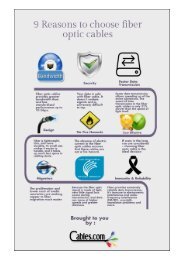Benefits of USB 3.0 And What Makes it Different
USB (Universal Serial Bus) is a universal connection used to connect electronic devices (like digital cameras, external hard drives, printers, etc.) to a computer. The idea was to replace all of the different connection types needed for different devices with one easy to use connector. http://www.cables.com/Category/usb-a-to-b.aspx
USB (Universal Serial Bus) is a universal connection used to connect electronic devices (like digital cameras, external hard drives, printers, etc.) to a computer. The idea was to replace all of the different connection types needed for different devices with one easy to use connector.
http://www.cables.com/Category/usb-a-to-b.aspx
- TAGS
- benefits
- www.cables.com
You also want an ePaper? Increase the reach of your titles
YUMPU automatically turns print PDFs into web optimized ePapers that Google loves.
<strong>Benef<strong>it</strong>s</strong> <strong>of</strong> <strong>USB</strong> <strong>3.0</strong><br />
<strong>And</strong> <strong>What</strong> <strong>Makes</strong> <strong>it</strong> <strong>Different</strong><br />
<strong>USB</strong> <strong>3.0</strong> is the third major version <strong>of</strong><br />
the Universal Serial Bus (<strong>USB</strong>) standard<br />
for interfacing computers and<br />
electronic devices<br />
<strong>USB</strong> (Universal Serial Bus) is a universal connection used to connect electronic<br />
devices (like dig<strong>it</strong>al cameras, external hard drives, printers, etc.) to a computer.<br />
The idea was to replace all <strong>of</strong> the different connection types needed<br />
for different devices w<strong>it</strong>h one easy to use connector.<br />
A number <strong>of</strong> changes have been implemented in <strong>USB</strong> <strong>3.0</strong> to satisfy the<br />
increased demands <strong>of</strong> external devices.<br />
Transfer Rate<br />
<strong>USB</strong> <strong>3.0</strong> adds a new transfer type<br />
called SuperSpeed or SS, 5 Gb<strong>it</strong>/s<br />
(electrically, <strong>it</strong> is more similar to<br />
PCI Express 2.0 but <strong>USB</strong> <strong>3.0</strong> have<br />
Serial AT Attachment)<br />
Data Transfer<br />
• <strong>USB</strong> <strong>3.0</strong> introduces full duplex data<br />
transfer.<br />
• Two <strong>of</strong> five lanes are reserved<br />
for transm<strong>it</strong>ting data, while another<br />
pair is dedicated to receiving data,<br />
meaning that <strong>USB</strong> <strong>3.0</strong> can read and<br />
wr<strong>it</strong>e data simultaneously<br />
at full speed.<br />
• Previous <strong>USB</strong> specifications did not<br />
support bi-directional data transfer.<br />
Power<br />
• The un<strong>it</strong> load has been increased<br />
to 150 mA & a configured device<br />
can draw up to six un<strong>it</strong> loads, which<br />
adds up to 900 mA.<br />
• This exceeds <strong>USB</strong> 2.0 by 80% and<br />
leads to faster recharging or<br />
powering <strong>of</strong> more than four<br />
devices from a single hub.<br />
• In add<strong>it</strong>ion, the minimum device<br />
operating voltage was dropped<br />
from 4.4 V to 4 V, which saves<br />
energy.<br />
Power Management<br />
• <strong>USB</strong> <strong>3.0</strong> suspends device polling,<br />
which is replaced by interrupt<br />
driven protocol.<br />
• As a result, idle devices won’t<br />
experience a power drain since<br />
a signal from the device is<br />
required to in<strong>it</strong>iate data transfer.<br />
• W<strong>it</strong>h <strong>USB</strong> 2.0 the host controller<br />
used to look for active transfers,<br />
slowly draining power.<br />
• Briefly, <strong>USB</strong> <strong>3.0</strong> supports idle,<br />
sleep, and suspend states, as<br />
well as link-, device-, and<br />
function-level power management.<br />
Physical Appearance<br />
The above described specifications are also represented in the physical<br />
appearance <strong>of</strong> <strong>USB</strong> <strong>3.0</strong>. While the cable was previously described to be<br />
thicker because <strong>it</strong> contains four more wires than <strong>USB</strong> 2.0, this appears<br />
not to be the case now.<br />
The plug, however, is a dead giveaway for <strong>USB</strong> <strong>3.0</strong>. It contains an<br />
add<strong>it</strong>ional set <strong>of</strong> connectors, as illustrated in the above image.<br />
<strong>USB</strong> <strong>3.0</strong> drive is like a thicker<br />
water pipe, where more<br />
information can travel at<br />
a faster rate<br />
Whereas <strong>USB</strong> 2.0 drive is a thinner<br />
water pipe where downloads<br />
are slower<br />
BROUGHT YOU BY:<br />
www.cables.com












